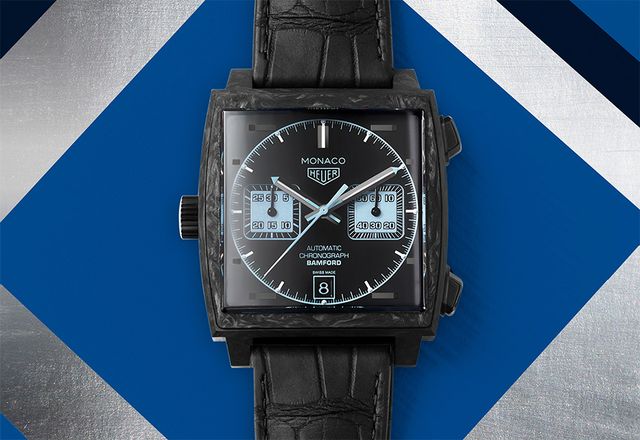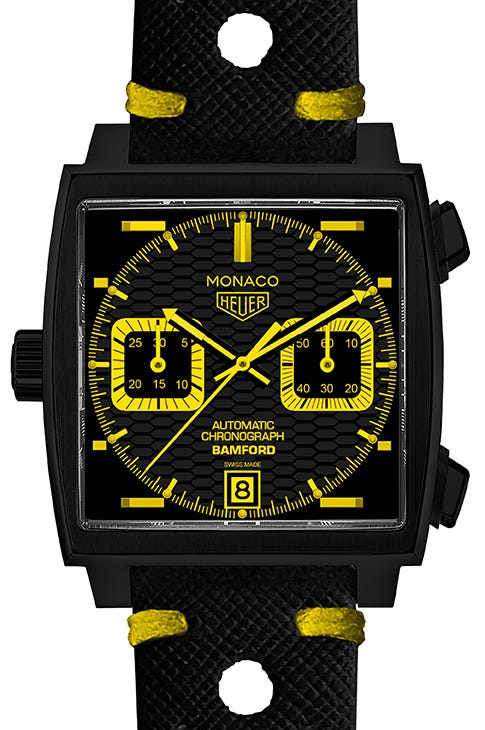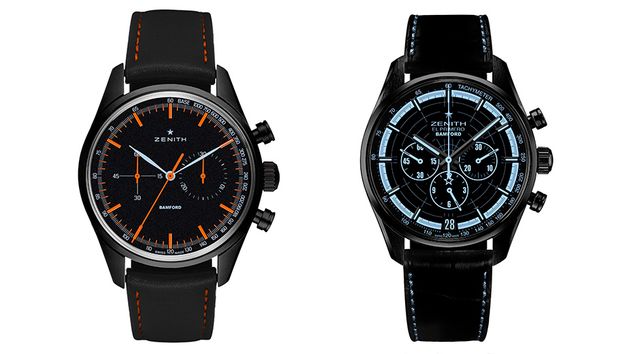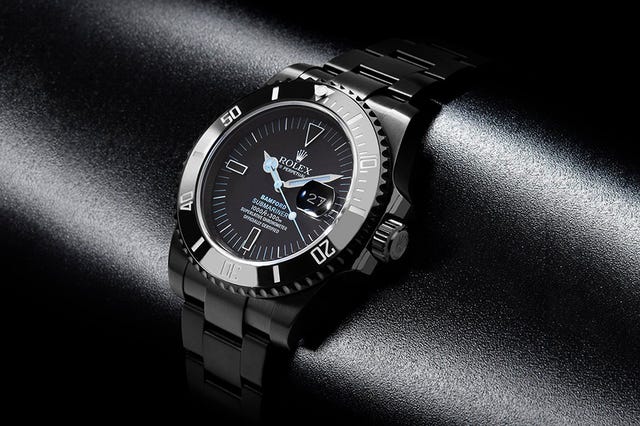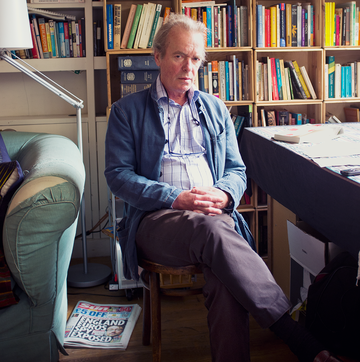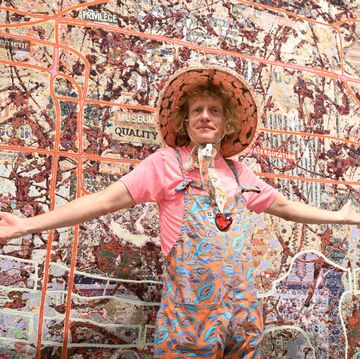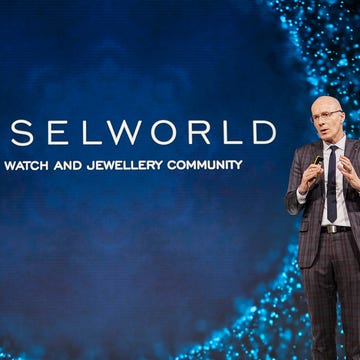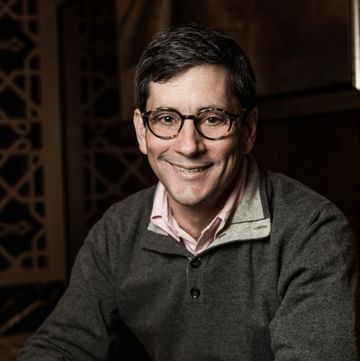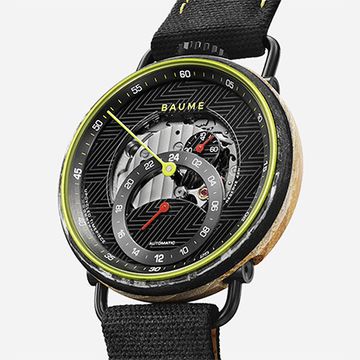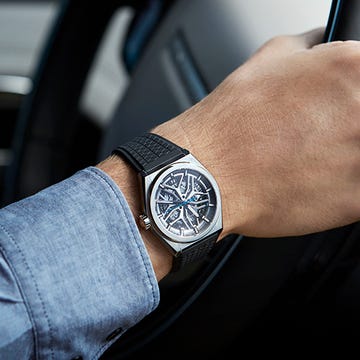Bamford Watch Design began in 2004, operating as an unofficial customiser of predominantly Rolex watches. At first a passion project for George, it drew on production techniques used in his father’s construction company JCB, and grew by word of mouth. Specialising in black PVD-coatings and a very bold use of colour (not to mention an irreverent sense of humour), BWD was disdained by the established watch world. That all changed in 2017 when it was announced that Bamford would be working as an official design partner with Bulgari, Zenith and TAG Heuer. In 2018, TAG Heuer and Bamford released their first ground-up collaboration, a Monaco chronograph in forged carbon using BWD’s signature black and blue colour scheme.
QP: Where did you develop a fascination for design?
GB: As a kid, from the age of about six, I used to get up very early every morning – I still get up about 4.30, 5.00am – and I used to go down to the kitchen or my parents’ sitting room and take the TV, the video, VCR or the juicer, anything, to bits and rebuild it. At the age of eight my grandfather taught me how to weld, and I learnt how to strip an engine down and rebuild it. I’m a frustrated engineer to this day, and my default position is ‘why can’t I do it?’ more than, ‘how do I do it?’.
QP: You went to Ampleforth College in Yorkshire. Did that nurture your creativity?
GB: Well, I got caught smoking by the Headmaster in my first week, so he knew who I was, and I was probably going to be expelled for some reason or other. My Housemaster took me to meet a photography teacher because he thought I’d like it. It was such a voyage of discovery, loading my own film and learning how to develop. I loved the physical aspect to it; getting my hands into something, understanding it and it coming alive. When I talk about being a frustrated engineer I wasn’t literally frustrated, but photography was my outlet. I went to Parsons [School of Design] in New York and studied photography for four years.
QP: Were your parents supportive? Did they want you to be an engineer?
GB: I’ll be 38 this year, and here’s the thing. I came out of university thinking God owed me a living and he didn’t. My father believes that you shouldn’t have a silver spoon in your mouth, you have to f***ing work and he always says, ‘go and do it in your own time and make a success or make a failure on your own time’ and I agree with him. It’s given me the drive to whatever I want.
QP: So you became a professional photographer, and this was your career path, not the world of watches?
GB: Yes – I became an assistant and I worked for some amazing photographers; Rankin and John Swannell over here, and in the States I worked for Paul Aresu and Antoine Verglas.
Then I came back to the UK, and I started getting some very big jobs, working as a fashion photographer, and also doing car photography. I was making very good scratch, I had built a studio in West London and I set this business [BWD] up at the same time, as my hobby business. I’ve still got the studio and it’s a good little business but now this is the main money-maker.
QP: How did that come about?
GB: When I went to Parsons, I was a flea market spotter of watches. I used to just go to markets and trade watches with people. That’s why I’ve got some really unusual watches now – like my ‘Surfboard’ Breitling, because I went for things that were just f***ing cool. I just cared about how I could get in, with my pen knife and a glasses screwdriver. So, I used to pop the back and figure out how the movement worked.
The idea of BWD as a business had been brewing and I’d actually been doing it a bit while I was in New York. But what brought it on was the recession; my [photography] rates were set to triple and instead they quartered. That was painful, and I slightly jumped ship.
We had set up a boutique called Bamford & Sons, my mother and me, that was a fashion label and my watches sat in there but we were doing vintage watches predominantly. We were selling vintage Heuers, vintage Omegas – someone lucked out on some of them. We used to sell Mark II Speedmasters for £600!
QP: Let’s talk about some of your design influences.
GB: I’m obsessed with cars. I buy weird cars, like I buy weird watches. I have a BMW Z1, for example, because I always loved the door sliding down. I’ve got a 911 Targa in gold with black wheels, it’s totally bizarre. My wife’s taken it on, she loves it. It’s the same with my watches: I have Omegas and Heuers, but they’re not the usual ones: I’ve got a Heuer Kentucky, I’ve got a digital Navitimer.
QP: Why do these oddball models from the 1960s and 70s appeal to you so much?
GB: It was just before the mass industrialisation of watch cases, so they had great versatility. It was all about these individuals, small runs, small production, it wasn’t a mass-market process. And a lot of the watches of that era are totally crazy; I used to think it was just a bunch of crazy designers smoking a bit too much. But it wasn’t that at all – they were just thinking “how do we get into that market? How do we do something different, how do we change?” And that’s something I loved; like the [Omega] ProPlof! You look at that and you’re like “Plo-what?” You can’t even pronounce it – has someone in marketing made sure that that name works around the world? No! It’s just great!
QP: Everything you’ve done with TAG Heuer and Zenith is a re-issue of something. Are there new designs which you love?
GB: I love the new Defy Lab, with that aluminium case and the new design, and some Hublot designs are just f***ing rock-star. But if you’re asking me what new designs have really rocked the watch world, not many. Richard Mille’s RM11 – that’s one.
QP: Recently we’ve seen more of a Bamford brand identity emerge. Where did the black and blue come from?
GB: I just thought “what’s a nice pop colour alongside black?” Everyone would have thought yellow because of JCB but I love blues. I’ve been working on it for years and it’s something I really associate with. It was amazing for the Monaco but I’m not doing every Bamford watch in that colour.
QP: You have always taken really iconic, well-loved designs, and changed them, sometimes drastically. Do you care very much what people think of your work?
GB: If someone has an opinion about something, it’s valid, it’s your opinion but it’s not my opinion. I create stuff that is for individuals, for their style. Of course I hope I’m doing a good job. We’re starting with amazing canvases, amazing products, and honestly, I’m getting a lot of people embracing what we do. How many of these watch brands have been asked by clients, “I want it in that green, can I have it in this, or that?” and they’ve always been told, “no”. Now they’re not being told “no” any more.
QP: Do you think you have moved the needle in that respect?
GB: No. Luxury fourteen years ago wasn’t personalisation, but that’s what luxury is now and it’s not me, it’s Louis Vuitton, Goyard, Ralph Lauren’s bespoke suits. I think the fashion industry moved the needle, but more importantly it’s the clients - we all want our own style!
QP: Whatever the reaction, the sales figures would imply you’re doing something right [all 500 pieces of the Bamford Monaco are now sold out]. Are you surprised that there aren’t more people trying to do what you have done?
GB: I think honestly, if I look back, my business had a Kodak moment where it could have ended just like that. It could have died a death by the watch brands doing it. Look at what IWC have just done [launching an online customisation tool for the Ingenieur chronograph]. There will be a lot more watch brands getting on board; either we’ll be working with a lot more watch brands or watch brands will be doing it themselves.
QP: You no longer modify Rolexes or other watches like you used to. Was that a condition of working with LVMH?
GB: If I’m working with any brand now I have to officially work with them. So the next brands that you’ll see me working with – and I’m alluding to something that I have already mentioned, although I can’t say what it is – I will have an official relationship with those brands, and a service contract.
QP: So, you don’t miss being a bit of a maverick outsider?
GB: No, I’m in the sun even on a rainy day. My business would have fallen off a cliff because the brands would have done something. Now I walk to work and I’m smiling.
QP: When you look at what LVMH have and what you’ve done, the obvious missing element is Hublot.
GB: Hublot does a lot of individual one-offs and personalisation; they have that in their business already. Are we both ruling it out? No. But it’s about asking ‘where do I fit in?’
QP: If you could work with any brand, what would you most want to work on?
GB: The first ever watch that I tinkered with was a Breitling Navitimer. I would love to work on one of those. The Omega Speedmaster, of course, but that’ll never happen. Oh, and I love the Portugieser, I love how simple that dial is.

